I just have to share this email I got from my friends Larry Kolczak and Betty Peterson in Ajijic, Mexico. I published photos of one of these caterpillars a few weeks ago. Here is the end of the story, told by Larry:
Since we live only a few hour’s drive from the mountains in Central Mexico where the Monarch butterflies from Eastern Canada and the U.S. migrate to spend the winter, we figured we’d better give them a helping hand by planting some milkweed in our garden. It is actually a more attractive plant than I imagined. And, it is the only plant on which Monarch butterflies lay their eggs.
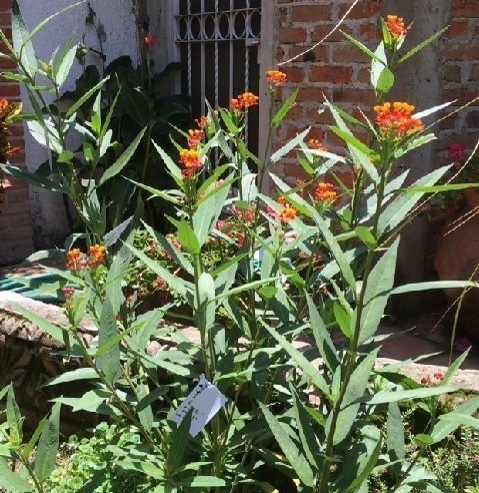
After just a week or two, Monarch’s found our plants and began laying their tiny white pearl-like eggs. Here is one right where the sunlit and shadowed parts of the leaf meet.
The eggs hatch about 4 days later. This little guy is busily munching on milkweed.
Milkweed contains some toxic chemicals that don’t affect the Monarch, but will sicken any predator that eats either the caterpillar or the butterfly. As a result, neither has to have camouflaged coloration. Their bright colors serve as a reminder to any predator who ever tried to eat one.
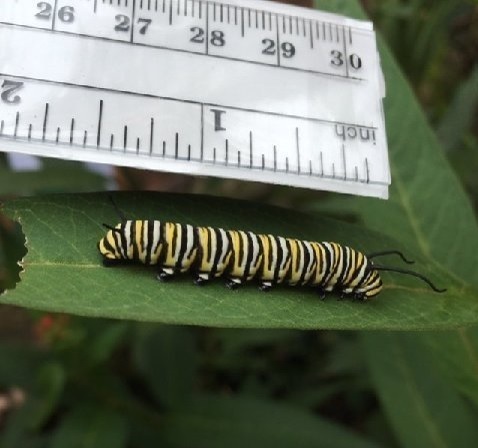
About 15 days after hatching, the caterpillars have grown to this size. That’s when they stop eating and wander off the milkweed plant looking for a bush or tree on which to begin their metamorphosis into an adult butterfly. At this stage, we usually lose track of where they went, so we collected one and raised it in a screened container.
After a day or two in the enclosure, the caterpillar hung by it’s tail and shed it’s caterpillar skin, replacing it with this shell like coating. In butterflies, this stage is called a chrysalis. Only moths make cocoons, which involve wrapping themselves in silk. The Monarch chrysalis is not much bigger than a Lima bean, and it has shiny gold dots around one part, called a necklace.
After about 11-12 days, the chrysalis begins to darken and become translucent. You can actually see the butterfly’s orange and black wings squished into the lower portion.
Our little guy emerged on the 12th day and crawled onto a stick to hang while blood was pumped into it’s shriveled wings.
About two hours later, the wings were fully expanded. But he wasn’t actually flapping them, or trying to fly.
We watched him for another hour or so until he decided to climb out of the container. Using a stick, I helped him climb out. He showed no reluctance to climb up the stick and onto my thumb. You may have noticed, I’m calling it a “him.” That’s because male Monarchs can be identified by the two little black dots in the orange part of their lower wings. These are scent glands that will help him attract mates.
I carefully carried our Monarch out to the garden and put him on a milkweed flower. By now, we had named him Marty after my wife’s son who, years ago had lived in Santa Cruz, CA which has it’s own colony of Monarchs during the winter. Every year, the State Park puts on a Monarch festival. One year, Marty had volunteered to play the part of “Captain Monarch” who dressed in a butterfly costume and slid down a zip line to entertain the kids.
He sat there quietly for about an hour, and then fluttered off to begin his new life.
Live long and prosper, Marty.




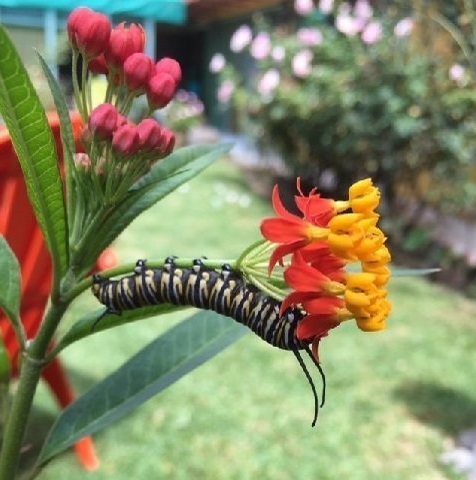

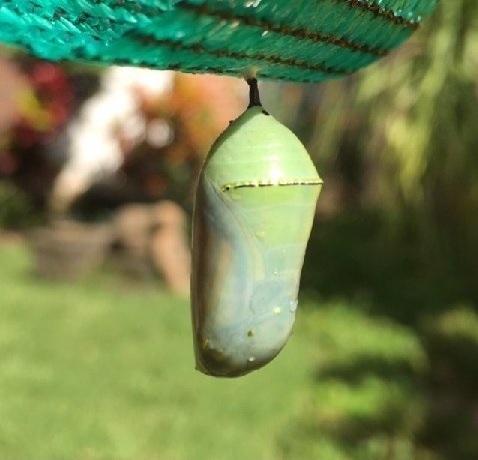
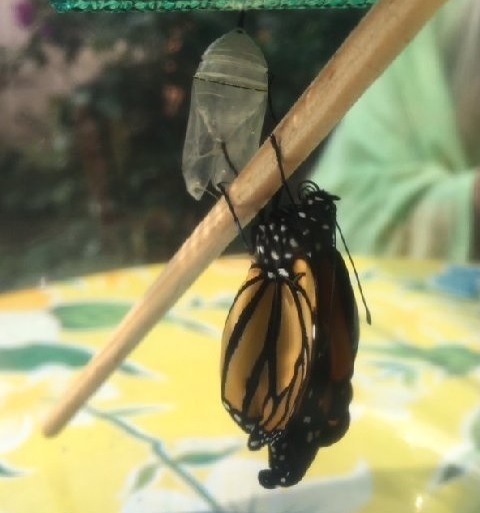

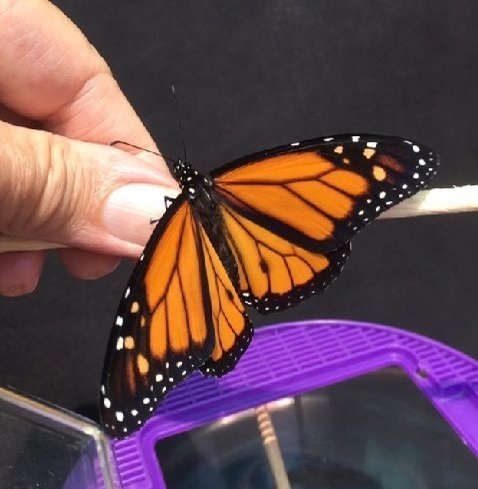
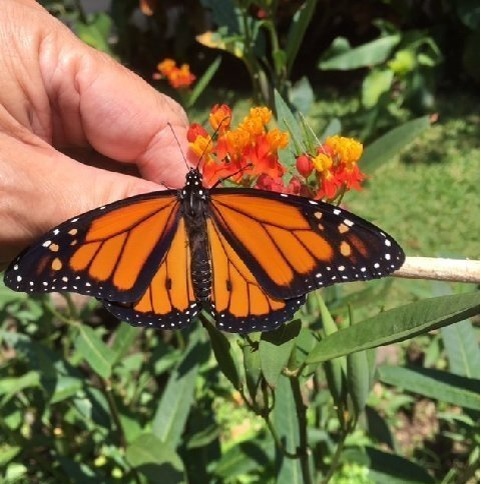

Doesn’t display photos… might be only me.
LikeLike
About to check it out. Forgottenman promised to get it straightened out..Just got back from the beach.
LikeLike
Okay, the photos are there now, Manja! Thanks, Forgottenman.
LikeLiked by 1 person
You’re welcome, Judy!
LikeLike
Such a neat series. We just got back a couple of hours ago. A day early, all is well and happy.
LikeLiked by 1 person
If you feel like sharing details, email moi. I’m on the move again tomorrow..Three different places in three nights, then back to St. Louis and won’t have to be the one making plans for awhile. Ahhhhh.
LikeLiked by 1 person
It feels good to be home. I am looking forward to sleeping in my own bed tonight. 😀 I’ll write you later.
LikeLiked by 1 person
I know what you mean. Great to visit friends and family but also great to be home.
LikeLike
Judy, say hello to my hometown for me, I was there in July for ten days, the longest period I have visited family in some years.
I love this posting, and I will reblog on my site, because of the incredible story and the name “Marty” given to the monarch butterfy.
LikeLike
What a wonderful post! My milkweed didn’t make it, but I’ll try again next year. Really terrific post and amazing pictures.
LikeLiked by 1 person
They are amazing people..Some day I’ll tell you about them. Meant to do a post on them but ran out of time.. Perhaps when I get back in MX.
LikeLike
very interesting-and the pics are beautiful!
LikeLike
They are truly such fascinating creatures; I love your photo series.
LikeLike
Ooh, this is excellent. Hail, Marty!
LikeLike
Great posting and I love the name given to the Monarch butterfly, “Marty.”
LikeLike
Reblogged this on Nomadic Adventurer and commented:
Great blog posting especially the name given to the beautiful Monarch butterfly, “Marty.”
LikeLike
This is a fun and fact filled post. Thank you so much for sharing your monarch experience.
LikeLike
Beautiful pictures. It’s such cool process to see them turn into butterflies.
LikeLike
Pingback: LARRY AND BETTY’S MONARCH ADVENTURE – LIFELESSONS, Judy Dykstra-Brown | SERENDIPITY
A wonderful description of the life of a monarch! There are way-stations on the butterflies’ trek all along coastal California — beautiful!
LikeLiked by 1 person
I saw the monarch butterfly trees on the beach in Big Sur and also saw them near Monterey and Santa Cruz. Years later, I saw them again in even vaster numbers in Michoacan, Mexico, where they come to lay eggs and die. That was quite a hike up into the mountains and I did it with two broken ribs!!
LikeLike
Lovely pictures and I enjoy their story. However, I’m still recovering mentally from our great caterpillar invasion which left me scarred.
LikeLike
Very awesome post!
LikeLike